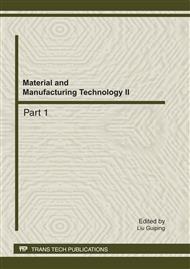p.128
p.133
p.138
p.142
p.147
p.152
p.158
p.163
p.168
Investigation of Grinding Surface Temperature: Experimental Measurements and Numerical Modeling
Abstract:
Main restriction for achievable material removing rate and simultaneously high quality parts in grinding process is the high specific energy requirements and consequently thermal damage to workpiece. In this work, a sequence of experimental tests were performed focused on grinding parameters including wheel speed, workpiece feed rate and depth of cut. Previously developed grindiable thermocouples were utilized to measure grinding surface temperature in each experiment. Feasibility of the grindable thermocouples in workpiece surface temperature measurement in the grinding process was investigated. Then, a 2-D finite element thermal model was created using ANSYS code based on the experimental data for numerical investigation. The model was used to predict grinding surface temperature in conditions of the experiments. A comparison between experimental and numerically predicted results for grinding surface temperature shows good agreements within an acceptable margin of error. The absolute average of errors is equal to 6.6%. Therefore, the proposed grindable thermocouple technique can be used in measurement of workpiece surface temperature and study of thermal aspects of grinding process.
Info:
Periodical:
Pages:
147-151
Citation:
Online since:
September 2011
Authors:
Price:
Сopyright:
© 2012 Trans Tech Publications Ltd. All Rights Reserved
Share:
Citation:


